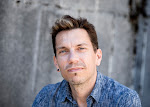It was instructive to see The Life and Death of Marina Abramović after having toured the
Whitney Museum’s show on 1970s performance art in New York City earlier in the
day. On the one hand, the heavily industrial, epically scaled, and highly
operatic work now playing at the Park Avenue Armory through December 21st couldn’t be further from the anti-spectacular, makeshift and micro aesthetic of
the loft and storefront performances by Jack Smith and Jill Kroesen and Sylvia
Palacios Whitman and Squat Theater whose surprisingly extensive and
well-preserved documentary traces comprise the Rituals of Rented Island show. At the same time, much of this
performance art, I was interested to discover, was very theatrical, especially
as it focused explicitly on objects and narrative.
That was never really the case with Abramović’s early
performance art, which largely used the artist’s own body to explore, over long
durations of time, extreme physical and emotional states. However, Abramović’s
collaborator on Life and Death, Robert
Wilson, was immersed in the New York scene documented at the Whitney: Rented Island showcases one of his early
loft pieces, which featured some of his earliest light- and movement-based
work. Perhaps not surprisingly from the director of Einstein on the Beach, it was the way Life and Death was lit and choreographed that I was most taken
with. Wilson uses a bank of fluorescent footlights and a series of follow-spots
in especially canny ways, and the repetition of different massings of bodies on
the stage during many of the scenes not only evoked images of Communist-era
militarism but also nineteenth-century tableaux vivants—appropriate for the
artist who took performance art into the museum and turned it into a kind of
living diorama. Of course, the music is also gorgeous, featuring not just the
haunting vocals of Antony, but also additional contributions from Nico Muhly,
William Basinski, and the Svetlana Spajić Group, whose keening Serbian folk
songs were a perfect counterpoint to Antony’s lyricism.
Not that everything worked. The whole piece could have been
at least a half-hour shorter, with many of the scenes going on for just a shade
longer than was necessary, self-indulgence perhaps being the necessary
byproduct when so many outsized artistic egos are collaborating together. Which
brings me to Willem Dafoe as the narrator. Like Abramović, Dafoe is now
something of an ex-communicant from the avant-garde performance scene, having
long ago been banished from the Wooster Group. And so his presence in this
piece carries several additional layers of meaning. Certainly he shoulders the
bulk of the work as far as storytelling goes—but it is nearly impossible to
separate the many roles he plays here (from Tito to Ulay) from the impish,
slightly demented self he necessarily brings with him courtesy of his many film
appearances and that inimitable voice.
As for Abramović herself, she is at once the centre of this
piece and paradoxically absent from it, spending much of the show offstage, or
quietly observing scenes from the sidelines. The one time she does stand alone
in the spotlight downstage, it is to sing—by and large a mistake. Having turned
herself into a bona fide personality
with her Artist is Present show at
MOMA in 2010 (and having, in many people’s minds, concomitantly pronounced the
death of performance art by acceding to and even willfully abetting not just
its reperformance, but its
institutionalization), it makes sense, on one level, that she would turn to the
theatre to explore the different personae
that could never be a part of the focused and durational explorations of self
(her own and others’) that formed her performance art practice. (And masks—from
the death masques that cover the faces of Abramović and her two avatars on
their funeral biers at the top of the show to the face paint that most of the
other performers sport—are featured very prominently in Life and Death.) Many of those personae, we are given to understand,
derive from Abramović’s painful childhood and this work functions, on one
level, as an elaborate form of artistic therapy, one in which Abramović exorcises, especially, the painful memories of her physically and emotionally
abusive mother.
And, indeed, at the end of the show, as Wilson pulls out all
the deus ex machina stops and hoists
Marina and her two angel-avatars into the air on pulleys while Antony and
performer Oren Bloedow sing of “Volcanoes of Snow,” we get a sense that the
artist is exactly where (when not branding herself on umbrellas and coffee mugs
in support of the performance art institute she is apparently building on the
Hudson) she has always wanted to be: starring in her own Greek tragedy.
P.




No comments:
Post a Comment